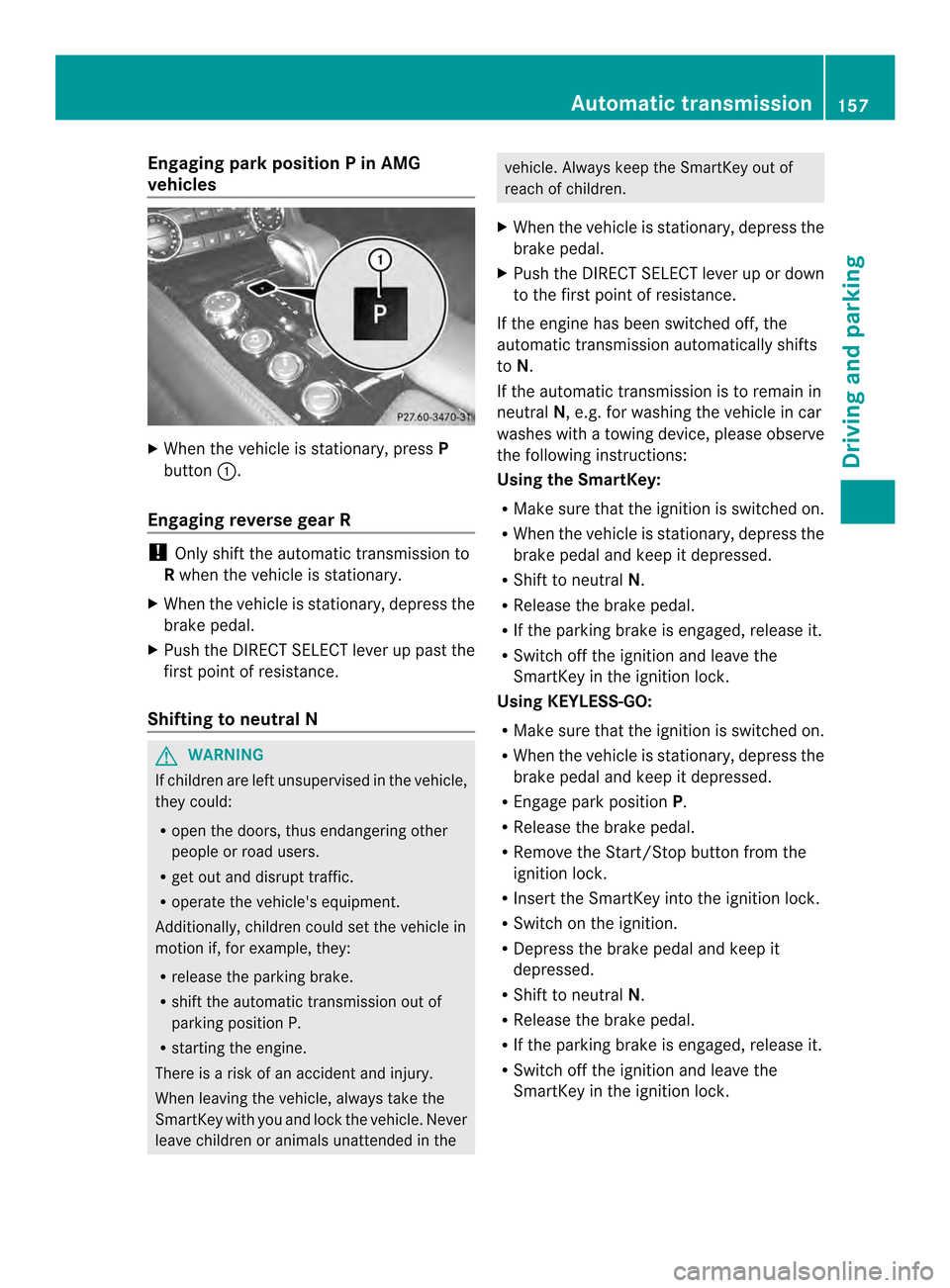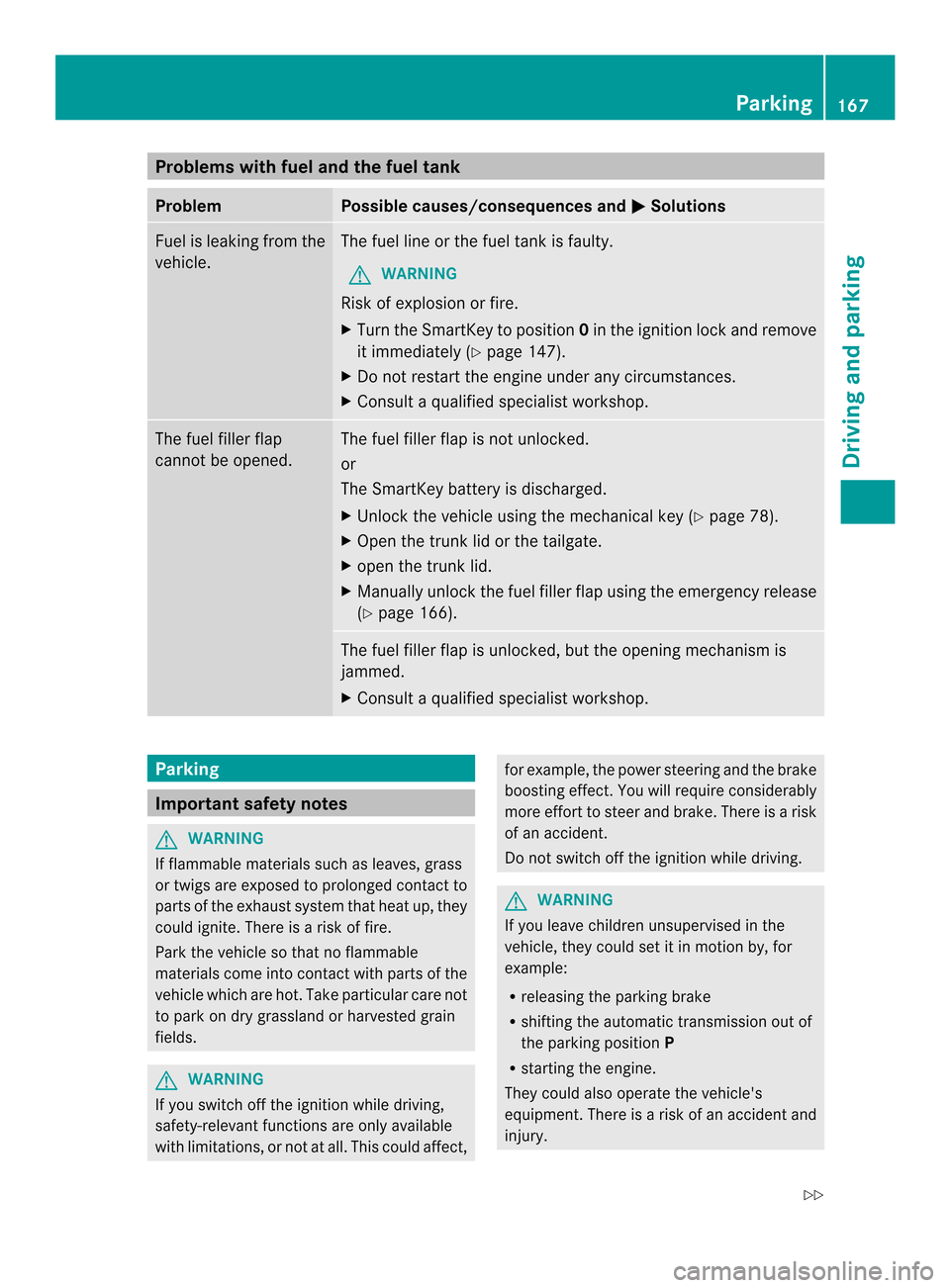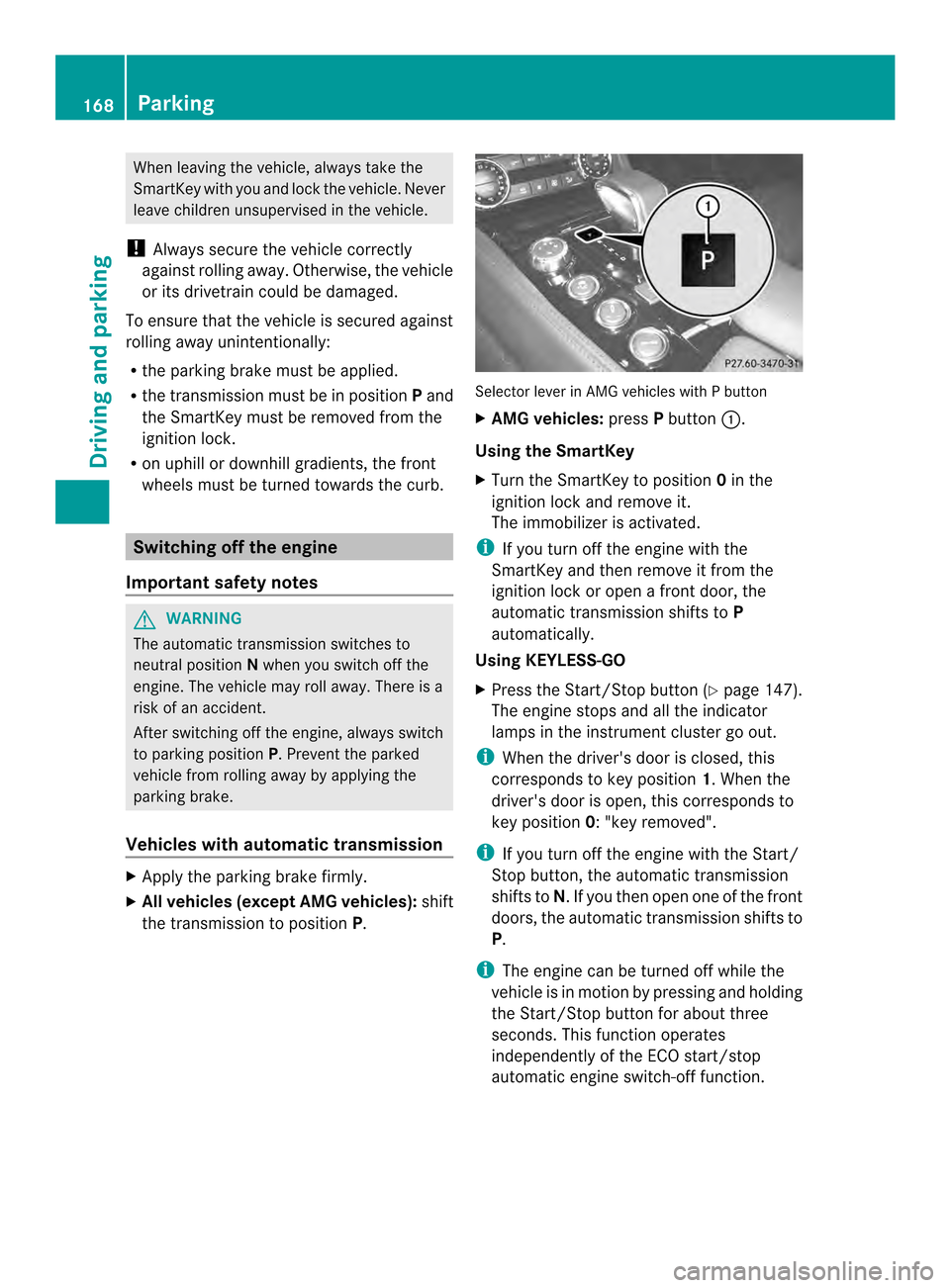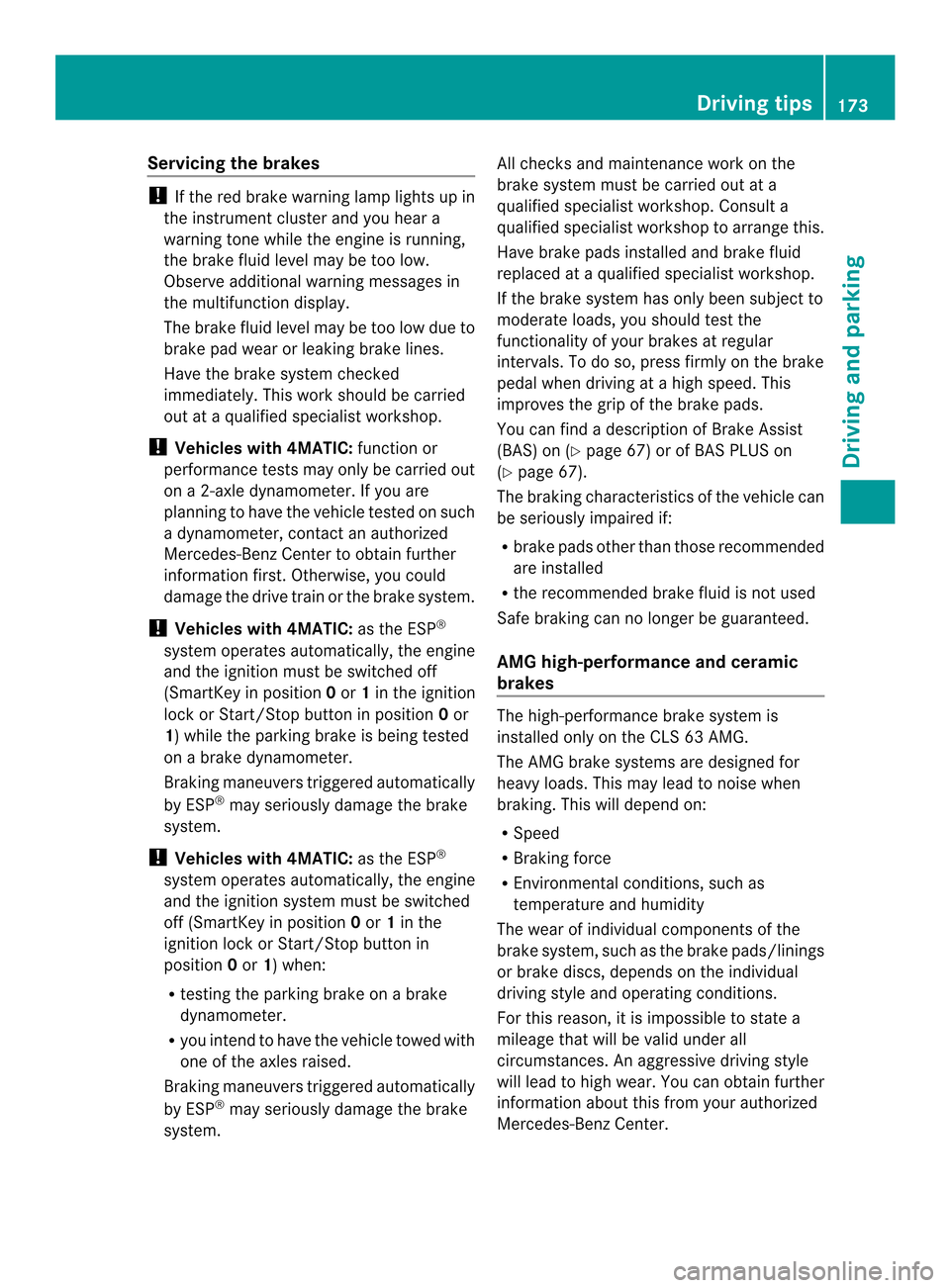lock MERCEDES-BENZ CLS-Class 2014 W218 Manual Online
[x] Cancel search | Manufacturer: MERCEDES-BENZ, Model Year: 2014, Model line: CLS-Class, Model: MERCEDES-BENZ CLS-Class 2014 W218Pages: 382, PDF Size: 5.36 MB
Page 157 of 382

Automati
ctransmission Important safety notes
G
WARNING
If th eengines pee disa bovethe idlin gspeed
and you engage transmission position Dor
R,t hevehicl ecould pull away suddenly. There
is ar iskofana ccident.
When engagin gtransmission position Dor R,
always firmly depress th ebrak epedal and do
no tsimultaneously accelerate. G
WARNING
The automatic transmission switches to
neutral position Nwhen you switc hoff the
engine. The vehicle may roll away. There is a
risk of an accident.
After switching off the engine, always switch
to parking position P.Prevent the parked
vehicle fro mrolling away by applying the
parking brake. Selector lever
Overview of transmission positions Selector lever in AMG vehicles with
Pbutton
0008 Park position with parking lock
000A Reverse gear
0006 Neutral
0007 Drive Transmission position and drive
program display !
If the transmission position display in the
multifunction display is not working, you
should pull away carefully to check whether
the desired transmission position is
engaged. Ideally ,you should select
transmission position Dand drive program
C.Don ot restric tthe shift range. 001A
Transmission position display
0010 Drive program display
The current position of the selector lever is
shown by the indicators next to the selector
lever.
The indicators light up when the SmartKey is
inserted into the ignition lock. The indicators
go out when the SmartKey is removed from
the ignition lock. DIRECT SELECTl
ever
Overview of transmission positions 0008
Park position with parking lock
000A Reverse gear
0006 Neutral
0007 Drive Automatic transmission
155Driving and parking Z
Page 158 of 382

The DIRECT SELECT lever is on the right of the
steerin gcolumn.
i The DIRECT SELECT lever alway sreturns
to its original position. The current
transmission position P,R, Nor Dappears
in the transmission position display
(Y page 155) in the multifunction display.
Transmission position and drive
program display !
If the transmission position display in the
multifunction display is not working, you
should pull away carefully to check whether
the desired transmission position is
engaged. Ideally, you should select
transmission position Dand drive program
E or S.Don ot restrict the shift range. 001A
Transmission position display
0010 Drive program display
The curren ttransmission position and drive
progra mappear in the multifunction display.
i The arrows in the transmission position
display show how and int owhich
transmission position syou can change
using the DIRECT SELECT lever.
Engaging par kposition P !
If th eengine speed is to ohigh or the
vehicle is moving, do not shift the
automatic transmission directly from Dto
R,f rom Rto Dor directly to P.The
automatic transmission could otherwise be
damaged. 0008
Park position with parking lock
000A Reverse gear
0006 Neutral
0007 Drive
X Push the DIRECT SELECT lever in the
direction of arrow P.
i The automatic transmission shifts into
park position Pautomatically:
R if you open the driver's door while the
vehicle is stationary in transmission
position Dor R
R if you open the door while traveling at
very low speeds in transmission position
D or R
HOLD function or DISTRONIC PLUS: if the
vehicle is braked using the HOLD function or
DISTRONIC PLUS, the automatic
transmission shifts automatically to
transmission position P.Inaddition ,atleast
one of the following condition smust be
fulfilled:
R the engin eisswitched off.
R the driver' sdoor is open and the seat belt
is not in the buckle. 156
Automatic transmissionDriving and parking
Page 159 of 382

Engaging park position
PinAMG
vehicles X
When th evehicle is stationary, press P
button 001A.
Engaging revers egear R !
Only shif tthe automatic transmission to
R when the vehicle is stationary.
X When the vehicle is stationary, depress the
brake pedal.
X Push the DIRECT SELECT lever up past the
first point of resistance.
Shifting to neutralN G
WARNING
If children are left unsupervised in the vehicle,
they could:
R open the doors, thus endangering other
people or road users.
R get out and disrupt traffic.
R operate the vehicle's equipment.
Additionally, children could set the vehicle in
motion if, for example, they:
R release the parking brake.
R shift the automatic transmission out of
parking position P.
R startingt he engine.
There is arisk of an accident and injury.
When leaving the vehicle, always take the
SmartKey with you and lock the vehicle. Never
leave children or animals unattended in the vehicle. Always keep the SmartKey out of
reach of children.
X When the vehicle is stationary, depress the
brake pedal.
X Push the DIRECT SELECT lever up or down
to the first point of resistance.
If the engine has been switched off, the
automatic transmission automatically shifts
to N.
If the automatic transmission is to remain in
neutral N,e.g. for washing the vehicle in car
washes with atowing device, please observe
the following instructions:
Using the SmartKey:
R Make sure that the ignition is switched on.
R When the vehicle is stationary, depress the
brake pedal and keep it depressed.
R Shift to neutral N.
R Release the brake pedal.
R If the parking brake is engaged, release it.
R Switch off the ignition and leave the
SmartKey in the ignition lock.
Using KEYLESS-GO:
R Make sure that the ignition is switched on.
R When the vehicle is stationary, depress the
brake pedal and keep it depressed.
R Engage park position P.
R Release the brake pedal.
R Remove the Start/Stop button from the
ignition lock.
R Insert the SmartKey into the ignition lock.
R Switch on the ignition.
R Depress the brake pedal and keep it
depressed.
R Shift to neutral N.
R Release the brake pedal.
R If the parking brake is engaged, release it.
R Switch off the ignition and leave the
SmartKey in the ignition lock. Automatic transmission
157Driving and parking Z
Page 160 of 382

Engaging drive position D
X
When th evehicle is stationary, depress the
brak epedal.
X Push th eDIRECT SELECT leve rdown past
the first point of resistance. Transmission positions
000D
Park position
Do not shift the transmission into
position
P(Ypage 167) unless the
vehicle is stationary. The parking
lock should not be used as abrake
when parking. In addition to
engaging the parking lock, you
must always apply the parking
brake to secure the vehicle.
If the vehicle electronics are
malfunctioning, the transmission
may be locked in position P.
Have the vehicle electronics
checked immediately at aqualified
specialist workshop. 0007
Reverse gear
Only shift the transmission to
R
when the vehicle is stationary. 000E
Neutral
Do not shift the transmission to
N
while driving. The transmission
could otherwise be damaged.
No power is transmitted from the
engine to the drive wheels.
Releasing the brakes will allow you
to move the vehicle freely, e.g. to
push it or tow it.
If ESP ®
is deactivated or faulty:
only shift the transmission to
position Nif the vehicle is in danger
of skidding, e.g. on icy roads.
! Rolling in neutral Ncan damage
the drive train. 0009
Drive
The automatic transmission
changes gear automatically. All
forward gears are available.
Changing gear
The automatic transmission shifts to the
individual gears automatically when it is in
transmission position D.This automatic
gearshifting behavior is determined by:
R as hift range restriction, if selected
R the selected drive program (Y page 159)
R the position of the accelerator pedal
R the road speed Driving tips
AMG vehicles When shifting down, the double-clutch
function is active regardless of the currently
selected drive program. The double-clutch
function reduces load change reactions and
is conducive to
asporty driving style. The
sound generated by the double-clutch
function depends on the drive program
selected. 158
Automatic transmissionDriving and parking
Page 167 of 382

!
Do not use diesel to refuel vehicles with a
gasoline engine. Do not switch on the
ignition if you accidentally refuel with the
wrong fuel. Otherwise, the fuel will enter
the fuel system. Even small amounts of the
wrong fuel could result in damage to the
fuel system and the engine. The repair
costs are high. Notify aqualified specialist
worksho pand have th efuel tan kand fuel
lines draine dcompletely.
! Overfilling the fuel tank could damage the
fuel system.
! Take car enot to spill any fuel on painted
surfaces .You could otherwise damage the
paintwork.
! Use afilter when refueling from afuel can.
Otherwise, the fuel lines and/or injection
system could be blocked by particles from
the fuel can.
Do not get into the vehicle again during the
refueling process. Otherwise, electrostatic
charge could build up again.
If you overfill the fuel tank,f uel could spray
out when the fuel pump nozzle is removed.
For further information on fuel and fuel quality
(Y page 374). Refueling
Opening/closing the fuel filler flap 001A
To open the fuel filler flap
0010 To insert the fuel filler cap 0024
Tire pressure table
0021 Fuel type to be used
The fuel filler flap is unlocked or locked
automatically when you open or close the
vehicle with the SmartKey or with KEYLESS-
GO.
The position of the fuel filler cap is displayed
0007 in the instrument cluster. The arrow
next to the filling pump indicates the side of
the vehicle.
Opening the fuel filler flap 001A
To open the fuel filler flap
0010 To insert the fuel filler cap
0024 Tire pressure table
0021 Fuel type to be used
X Switch the engine off.
X Remove the SmartKey from the ignition
lock.
X KEYLESS-GO: open the driver’s door.
This corresponds to key position 0:"key
removed".
The driver’s door can be closed again.
X Press the fuel filler flap in the direction of
arrow 001A.
The fuel filler flap opens slightly.
X Open the fuel filler flap fully.
X Turn the fuel filler flap counter-clockwise
and remove it. Refueling
165Driving and parking Z
Page 168 of 382

X
insert the fuel filler cap int othe holder on
the insid eoffuel filler flap 0010.
X Completely insert the filler nec kofthe fuel
pump nozzle into the tank,h ook in place
and refuel.
X Only fill the tank until the pump nozzle
switches off.
i Do not add any more fuel after the pump
stops filling for the first time. Otherwise,
fuel may leak out.
Closing the fuel filler flap X
Replace the cap on the filler neck and turn
clockwise until it engages audibly.
X Close the fuel filler flap.
i Close the fuel filler flap before locking the
vehicle. Otherwise, the locking pin of the
central locking prevents the fuel filler flap
from closing.
i If you are driving with the fuel filler cap
open, the 0007reserve fuel warning lamp
flashes. Amessage appears in the
multifunction display (Y page 251).
In addition, the 000ACheck Engine warning
lamp may light up (Y page 273).
For further information on warning and
indicator lamps in the instrument cluster,
see (Y page 273). Fuel filler flap emergency release
X
open the trun klid.
X Slide down the parcel net. X
Open the right-han dside trim panel.
X Remove the first-aid kit (Y page 320).
X Detach the emergenc yrelease from
retainer 001A.
X Pull the emergency release in the direction
of arrow 0010.
The fuel filler flap is unlocked.
X Open the fuel filler flap. 166
RefuelingDriving and parking
Page 169 of 382

Problems with fuel and the fuel tank
Problem Possible causes/consequences and
000B Solutions
Fuel is leaking from the
vehicle. The fuel line or the fuel tank is faulty.
G WARNING
Risk of explosion or fire.
X Turn the SmartKey to position 0in the ignition lock and remove
it immediately (Y page 147).
X Do not restart the engine under any circumstances.
X Consult aqualified specialist workshop. The fuel filler flap
cannot be opened. The fuel filler flap is not unlocked.
or
The SmartKey battery is discharged.
X
Unlock the vehicle using the mechanical key (Y page 78).
X Open the trunk lid or the tailgate.
X open the trunk lid.
X Manuallyu nlock the fuel filler flap using the emergency release
(Y page 166). The fuel filler flap is unlocked, but the opening mechanism is
jammed.
X
Consult aqualified specialist workshop. Parking
Important safety notes
G
WARNING
If flammable materials such as leaves, grass
or twigs are exposed to prolonged contact to
parts of the exhaust system that heat up, they
could ignite. There is arisk of fire.
Park the vehicle so that no flammable
materials come into contact with parts of the
vehicle which are hot. Take particular care not
to park on dry grassland or harvested grain
fields. G
WARNING
If you switch off the ignition while driving,
safety-relevant functions are only available
with limitations, or not at all. This could affect, for example, the power steering and the brake
boosting effect.Y
ou will require considerably
more effort to steer and brake. There is arisk
of an accident.
Do not switch off the ignition while driving. G
WARNING
If you leave children unsupervised in the
vehicle, they could set it in motion by, for
example:
R releasing the parking brake
R shifting the automatic transmission out of
the parking position P
R starting the engine.
They could also operate the vehicle's
equipment. There is arisk of an accident and
injury. Parking
167Driving and parking
Z
Page 170 of 382

When leaving the vehicle, alway
stake the
SmartKey with you and lock the vehicle. Never
leave children unsupervised in the vehicle.
! Always secure the vehicle correctly
against rolling away .Otherwise, the vehicle
or its drivetrai ncould be damaged.
To ensure that the vehicle is secured against
rolling away unintentionally:
R the parking brake must be applied.
R the transmission must be in position Pand
the SmartKey must be removed from the
ignition lock.
R on uphill or downhill gradients, the front
wheels must be turned towards the curb. Switching off the engine
Important safety notes G
WARNING
The automatic transmission switches to
neutral position Nwhen you switch off the
engine. The vehicle may roll away.T here is a
risk of an accident.
After switching off the engine, always switch
to parking position P.Prevent the parked
vehicle from rolling away by applying the
parking brake.
Vehicles with automatic transmission X
Apply the parking brake firmly.
X All vehicles( except AMG vehicles): shift
the transmission to position P. Selector lever in AMG vehicles with
Pbutton
X AMG vehicles: pressPbutton 001A.
Using the SmartKey
X Turn the SmartKey to position 0in the
ignition lock and remove it.
The immobilizer is activated.
i If you turn off the engine with the
SmartKey and then remove it from the
ignition lock or open afront door, the
automatic transmission shifts to P
automatically.
Using KEYLESS-GO
X Press the Start/Stop button (Y page 147).
The engine stops and all the indicator
lamps in the instrumentc luster go out.
i When the driver's door is closed, this
corresponds to key position 1.When the
driver's door is open ,this corresponds to
key position 0:"key removed".
i If yo uturno ff the engine with the Start/
Stop button, the automatic transmission
shifts to N.Ifyou then open one of the front
doors, the automatic transmission shifts to
P.
i The engine can be turned off while the
vehicle is in motion by pressing and holding
the Start/Stop button for about three
seconds. This function operates
independently of the ECO start/stop
automatic engine switch-off function. 168
ParkingDriving and parking
Page 171 of 382

Parking brake
G
WARNING
If you must brake the vehicle with the parking
brake, the braking distance is considerably
longer and the wheels could lock. There is an
increased danger of skidding and accidents.
Only use the parking brake to brake the
vehicle when the service brake is faulty. Do
not apply the parking brake too firmly. If the
wheels lock, release the parking brake until
the wheels begin turninga gain.G
WARNING
If you leave children unsupervised in the
vehicle, they could set it in motion by, for
example:
R releasing the parking brake
R shifting the automatic transmission out of
the parking position P
R startingt he engine.
They could also operate the vehicle's
equipment. There is arisk of an accident and
injury.
When leaving the vehicle, always take the
SmartKey with you and lock the vehicle. Never
leave children unsupervised in the vehicle. If you brake the vehicle with the parking
brake, the brake lamps will not light up. X
To apply: depress parking brake 0010firmly.
When the engine is running, the 0004(USA
only) or 0001(Canada only) indicator lamp
lights up in the instrumen tcluster.
X To release: depressthe brak epedal and
keep it depressed.
X Pull release handle 001A.
When the ignition is switched on or the
engine is running, the 0004(USA only) or
0001 (Canada only) indicator lamp goes out
in the instrumen tcluster. Parking th
evehicle for along period
If you leave th evehicle parked for longer than
four weeks, th ebattery may be damage dby
exhaustive discharging.
If you leave th evehicle parked for longer than
six weeks, th evehicle may suffer damage as
ar esult of lack of use.
X Visit aqualifie dspecialist workshop and
seek advice.
i You can obtain informatio nabout trickle
chargers from aqualifie dspecialist
workshop. Driving tips
General notes
Important safety notes G
WARNING
If you switch off th eignitio nwhile driving,
safety-relevant functions are only available
with limitations, or not at all. This could affect,
for example, the power steering and the brake
boosting effect.Y ou will require considerably
more effort to steer and brake. There is arisk
of an accident.
Do not switch off the ignition while driving. G
WARNING
If you operate mobile communication
equipment while driving, you will be Driving tips
169Driving and parking
Z
Page 175 of 382

Servicing the brakes
!
If the red brake warning lamp lights up in
the instrumen tcluster and you hear a
warnin gtonew hile the engine is running,
the brak efluid level may be too low.
Observe additional warnin gmessages in
the multifunction display.
The brak efluid level may be too low due to
brak epad wear or leakin gbrak elines.
Have the brak esystem checked
immediately. This work should be carried
out at aqualified specialist workshop.
! Vehicles with 4MATIC: function or
performanc etests may only be carried out
on a2 -axle dynamometer. If you are
planning to have the vehicle tested on such
ad ynamometer, contac tanauthorized
Mercedes-Ben zCenter to obtain further
information first. Otherwise, you could
damage the drive train or the brak esystem.
! Vehicles with 4MATIC: as the ESP®
system operates automatically, the engine
and the ignition must be switched off
(SmartKey in position 0or 1in the ignition
lock or Start/Stop button in position 0or
1)w hile the parking brak eisbeing tested
on abrak edynamometer.
Brakin gmaneuvers triggere dautomatically
by ESP ®
may seriousl ydamag ethe brake
system.
! Vehicles with 4MATIC: as theESP®
system operate sautomatically, th eengine
and th eignition system must be switched
off (SmartKey in position 0or 1in the
ignition loc korStart/Sto pbutto nin
position 0or 1)w hen:
R testing th eparking brak eonabrake
dynamometer.
R you inten dtohave th evehicl etow ed with
on eoft heaxle sraised.
Braking maneuvers triggered automatically
by ESP ®
may seriousl ydamag ethe brake
system. All check
sand maintenance work on the
brak esystem must be carried out at a
qualified specialist workshop. Consult a
qualified specialist worksho ptoarrangethis.
Hav ebrak epads installed and brak efluid
replace dataq ualified specialist workshop.
If th ebrak esystem has only been subject to
moderat eloads ,you should test the
functionalit yofyour brakes at regular
intervals. To do so, press firmly on th ebrake
pedal when driving at ahigh speed. This
improve sthe gripoft hebrak epads.
You can fin dadescription of Brake Assist
(BAS) on (Y page 67)orofBASPLU Son
( Ypage 67).
The braking characteristics of th evehicl ecan
be seriousl yimpaired if:
R brak epads other than those recommended
are installed
R ther ecommended brak efluid is no tused
Safe braking can no longer be guaranteed.
AMG high-performance and ceramic
brakes The high-performance brake system is
installed only on the CLS 63 AMG.
The AMG brake systems are designed for
heavy loads. This may lead to noise when
braking. This will depend on:
R
Speed
R Braking force
R Environmental conditions, such as
temperature and humidity
The wear of individualc omponentsofthe
brake system, such as the brake pads/linings
or brake discs, depends on the individual
driving style and operating conditions.
For this reason, it is impossibletos tate a
mileage that will be valid under all
circumstances. An aggressive driving style
will lead to high wear. You can obtain further
information aboutt his from your authorized
Mercedes-Ben zCenter. Driving tips
173Driving and parking Z